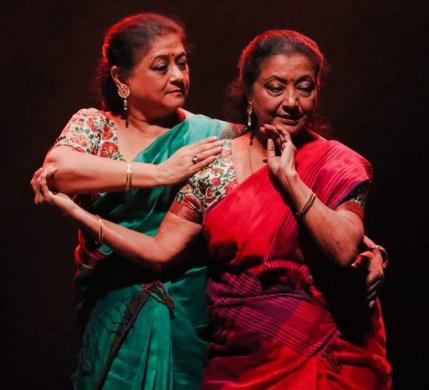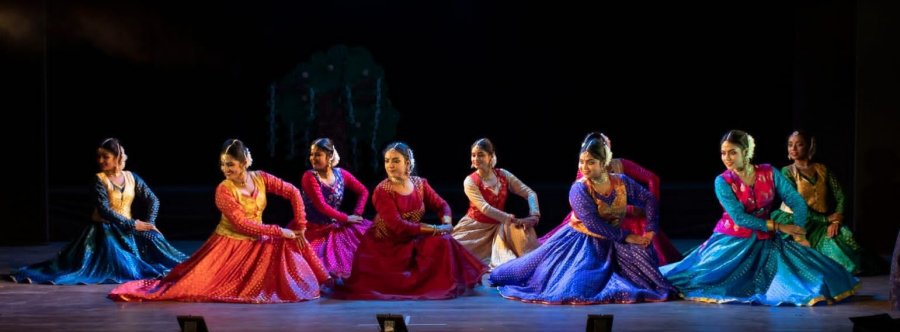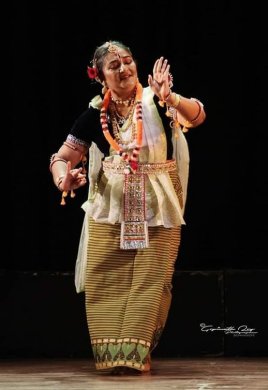
|   |

|   |
Azadi ki Leher and Shraddanjali, Dhrupadi and Manipuri Dance Festival - Tapati Chowdhurie e-mail: tapatichow@yahoo.co.in October 28, 2023 The two day long festival of 'Azadi ki Leher and Shraddanjali' celebrated by Kathak exponent of Lucknow Gharana, Paromita Maitra, at Purbashree Auditorium, EZCC, Kolkata was one-of-its-kind, where the stage was provided to classical dances of other genres too. Umesh Shetty of the Temple of Fine Arts, Malaysia, Guru Ashimbandhu Bhattacharya of Upasana Centre for Dance, Mamata Shankar Dance Company, Saraswat Sanskriti Kendra of Guru Anita Mallick, Prerna Centre of Performing Arts of Luna Poddar, Darpani Centre of Performing Arts of Arnab Bandyopadhyay, Ghungroo Dance Academy of Madhumita Roy and Dr. Pompi Paul of Kalpodip presented their pieces in this festival on day one. On the second day, a documentary on Pandit Birju Maharaj was shown. Performances of Odissi group of Poushali Mukherjee, Kathak groups of Ramaprasad Chattopadhyay, Sushmita Chatterjee, Kajal Misra; Sanskritiki Sreyaskar's Sohini Debnath and Debashree Bhattacharya, and solos by Rohini Shetty, Nilopa Maitra; Manipuri group of Priti Patel with Thangta and live music, solo Kathak with live music by Ipsita Misra, besides the duet with live music of Saswati Sen and Vaswati Misra were showcased. A seminar was held where the speakers besides the Chief Guest Sonal Mansingh were Dr.Mahua Mukherjee, Dr. Piyal Bhattacharya, Pt Chetan Joshi, Chadroday Ghosh, Guru Ratikant Mohapatra and Guru Saswati Sen who gave their valuable inputs about the aesthetics of our performing arts. The festival felicitated SNA awardees of 2023 from West Bengal in the category of dance. The phrase 'unity in diversity' coined by Jawaharlal Nehru is most appropriate to describe India, which in spite of its diversity with many languages, religions, castes, creed, colour, race, live in unity. "Bharat- Ek Anokha Raga" by Paramita Maitra was based on this noble idea. The intention of the choreographer was to present the beauty of the different classical dance forms that exist in the length and breadth of the country. Just as a raga can be played in the various musical instruments creating a harmonious melody, so it is with the dance forms too. The depiction of the theme in flawless Kathak style by Paramita's repertory group was much appreciated. The artistic director Ashimbandhu Bhattacharya of Upasana Centre for Performing Arts known for his subtle abhinaya, presented Ghalib's lyric 'Yaadein'. His dancers were seen gliding through the stage with the beauty of an eternal piece of art which is not for an age but for all times. Mamata Shankar Dance Company performed 'Yudhhajatra' based on a ritual of Rajasthan, where the battle ready warriors' forehead and swords are anointed and smeared with vermillion respectively by their womenfolk to glorify courage, a touching portrayal of a tradition that have inspired poets, painters and artists from time immemorial. The piece 'Raindrops, Sunbeam and Thunder' was rather a romantic piece of work which captured the beauty of falling raindrops, piercing rays of the sun and the dark clouds playing a game of hide and seek. 'Tindana' based on a popular song of Bengal dealt with the subject of young people revelling in the joy of flying kites. The creative style of dance was like the flowing of a river that goes uninhibited on its own path ushering in joy. The group made quite an impression on the audience. Saraswat Sanskriti Kendra of Anita Mallick presented 'Arghya' or 'Offering to Mother India.' Prerna Centre for Performing Arts of Luna Poddar presented 'Darbari' on raag Darbari Kanada or simply raag Darbari as it is popularly known. The presentation incorporated the various elements of Kathak dance creating a beautiful tapestry of kaleidoscopic impressions, exploring several patterns reflecting the aesthetic beauty of nritya. This innovative presentation was an amalgamation of modern yet traditional attributes of Kathak dance. Music composition and sitar were by Jayanta Banerjee, tabla by Soumen Sarkar, choreography was by Luna Poddar. Darpani ensemble of Arnab Bandyopadhyay danced 'Shrita Kamala'- an ashtapadi from Jayadeva's Geeta Govinda. Arnab choreographed his piece based on the composition by Guru Kelucharan Mohapatra. Anuranan by Ghungroo Dance Academy of Madhumita Roy was Dhrupadangi Kathak. It unearthed the tradition of symbiotic relation between Gayan-Vadan-Nritya in the form of Dhrupad nritya that flourished during the reign of Mansingh Tomar in the 15th century. Music was imaginatively recapitulated by Pt. Umakant Gundecha. Pompi Paul presented Ram Bhajan, which was originally composed by Guru Poushali Mukerjee and was re-choreographed by her. In the sanchari bhava, episodes from Ramayana such as Ahalya Uddhar, Sabari Moksham, Kevat Prasang were enacted. On the second day of the festival, students of Paramita Maitra offered their tribute to the doyen of Kathak dance, Pt. Birju Maharaj, after which kathakas Sohini and Debashree presented self-choreographed Sanjog Raqs or celebration, where they displayed the quintessential multiplicity of Kathak as a dance form, voyaging with the detailed precision of every minute movement of head, torso, limbs, footwork and spins. The subtle nuances found its expression as the dancers converse with varied percussion instruments, celebrating the inherent joy of dance. The music for Raqs has been composed by Ustad Sabir Khan. Poushali Mukherjee's disciples danced Kirwani Pallavi composed by Guru Kelucharan Mohapatra with graceful and lyrical movements. Ramaprasad Chattopadhyay and his disciples gifted the festival with 'Abhyas,' a remarkable and an imaginative way of telling the story of the dancers' toil through the art of dramatization. Susmita Chatterjee of Stuti educated the audience in showcasing the blending of folk music with Turkish, Arabic, and Western elements in Kathak. She also showcased the technical aspects of the form and its wide range of footwork and rhythm. She traced Kathak's deep roots with Indian culture. Her group was accompanied by Jayanta Banerjee, Subir Thakur and Soumyajit Ghosh. Kajal Mishra of Jailal Akademy of Music's presentation of rhythmic expression or 'Abhivyakti' was about the use of music and dance across cultures as a powerful language to convey emotions, narratives and creative ideas. The world of rhythm and spirituality converging in the realms of Dhamaar Taal, Tevra Taal, and the divine figure of Lord Shiva, revealed the connection between music, mythology, and devotion. Choreography was by Kajal Mishra Roy, while the music composition was by Sunando Mukherjee. Nilopa Maitra's performance of Kathak had clear signs of an emerging talent. Melei Leisna - The Golden Orchid presented by the Anjika group of Priti Patel was an excerpt from a tribute to her mentor and guide Maharajkumari Binodini Devi. Melei Leisna, the mesmerising golden orchid, is offered at the temple of Lai Thangjing at Moirang. It is also a symbol of romance where the lover gifts this to his beloved. This concept was Maharajkumari Binodini Devi's and the choreography was by Priti Patel.  Ipshita Misra The performance of kathaka Ipshita Misra - daughter of Vaswati Misra - proved Kathak to be in the right hands. Respectfully, she genuflected to the many qualities of Goddess Durga before launching off to show how powerful she is in the technical aspects of the form. In Taal Teentaal, she had surprises coming our way from every corner. Armed with both speed and perfection and a clear sense of laya, she rendered the best of her inherited tradition and captured the attention of the audience from the beginning to the end.  Vaswati Misra and Saswati Sen Vaswati Misra and Saswati Sen performed impromptu on the incidents that led to the battle between Rama and Ravana. To equip himself with strength to fight and defeat Ravana, a devotee of Shiva-Rama sought to appease Devi Chandrika with 108 blue lotuses to hear his prayers in person, but tragically there were only 107 lotuses. To fulfil his worship he was going to pick one of his eyes which was like a blue lotus. But his loyalty won the day. Devi appeared before him and wished him all success. Their dramatization of the event through dialogue, dance, miming and rhythm won them their day. The audience watched their power-packed performance with appreciation. DHRUPADI 'Nritya Dhrupadi Music and Dance Research Centre' is a cultural organization, affiliated to Pracheen Kala Kendra, Chandigarh, founded in 2007 by Sucharita Datta Ghata proficient in both the Lucknow and Jaipur Gharana Kathak as well as Bharatanatyam - to preserve cultural heritage of Indian classical dances. Some of Sucharita's noteworthy presentations are Ashtanayika, Navarasa, Holi and Panchabhoota. Dhrupadi 2023 was performed with live music. The evening commenced with Ganesh Vandana "Gajamukha vadana lage ati sundara" in Kathak style to a composition of Pt.Birju Maharaj by the students of Nritya Dhrupadi followed by Ganesha Pancharatnam Stotra by Adi Shankaracharya in Bharatanatyam style to overcome obstacles. Guest artist Luna Poddar presented Thaat, Upaj, Amad, Utthan (16 beats) Vilambit teentaal and Parmelu, tukda, toda, paran, tihai, ladi in drut teentaal in her own inimitable style. Her concluding item was thumri - "Eri sakhio mori piya ghar aye." She was accompanied by Subir Thakur on tabla, Joydeep Sinha on vocal, Chandrachur Bhattacharjee on sitar and Kamalesh Mishra on sarangi. Kathak Guru Ramaprasad Chattopadhyay performed Shiv Vandana, "Prabhum prana natham vibhum biswa natham." He followed it up with displaying the technical aspects of Kathak. His accompanying artistes were Biswajit Pal on tabla, Subhashish Bhattacharyya on vocal, Chandrachur Bhattacharjee on sitar and Kamalesh Mishra on sarangi.  Sucharita Datta Ghata's disciples Nritya Dhrupadi Music and Dance Research Centre presented the dance drama 'Sravan Gatha' to recorded music. The choreography began with the summer season that precedes monsoon. The sway of the scorching heat of the sun shown through the mythological story of the sun god riding the sky on his chariot drawn by seven horses was followed soon after by cloud burst ushering in monsoon. The first tiny drops of rain are taken over by huge drops soon to turn into torrential rain, were aptly shown. Hindustani music abounds in several genres of musical forms rich in drawing portraits of rain such as Dhrupad, Khayal, Thumri, Kajri, Gazal, Jhula and Tarana, which were used to bring out the beauty of the season. The monsoon season was picturised through traditional bols and rhythmic compositions of tukra, toda, paran, parmelu tihai and tatkar. The yearning of Rama for Sita, birth of Krishna, beauty of Ghanashyam's flute music with the joyous dance of peacocks were portrayed in the backdrop of the rain. 'Sravan Gatha' or the story of the monsoon would be incomplete without bringing in the nayikas - the inclusion of the characteristics of an Abhisarika nayika and Viraha-uthkhantitha nayika were apt. Sucharita Dutta Ghata's choice of lyrics from great poets was commendable. She was supported by vocalist Arindam Bhattacharjee, Purba Pratitundi, percussionist Biswajit Pal, sitarist Chandrachur Bhattacharjee, sarangi player Umesh Mishra with the voiceover by Gangotri Banerjee and Sucharita Datta Ghata herself brought a wholeness to the drama with her concept and choreography. Solo Kathak recital by Saswati Sen was the highlight of the evening. She regaled the audience with the 13 beat Jayat Taal, besides presenting Birju Maharaj's various beautiful compositions. She concluded her performance with a Dadra, "Mera sainya bhel baiman." INTERNATIONAL CLASSICAL MANIPURI DANCE FESTIVAL It was organized by Dr. Sruti Bandopadhay's Sruti Performing Troupe to pay their tribute to legendary Manipuri Guru Bipin Singh from Cachar, an adjacent district of Manipur, at Satyajit Ray Auditorium, Kolkata, in collaboration with ICCR. The program consisted of a dozen pieces composed by the guru presented in two segments - the nritta or pure dance and nritya or abhinaya compositions. His tryst with various taalas of Manipur was also showcased. In the inaugural piece, Sruti Performing Troupe presented Mangalacharan hailing the eternal lovers Krishna and Radha and seeking their blessings with soft and graceful movements of the form. Darshana Jhaveri, the senior most disciple of Guruji, described Krishna in the inimitable style of her guru. In Krishna Roop Varnan, the dancers engaged themselves in describing the beauty of Krishna, who is an ocean of bliss and spiritual joy. Krishna dancing with the sound of his bells and the tinkling of his ornaments with the gopis in different rhythms was timeless. The eleven matra beat had a mesmerising effect. Radha Nartan that followed soon after by the disciples of Sruti Bandopadhay was culled out in the choicest vocabulary of Manipuri dance and performed in group.  Sruti Bandopadhay Some of the rare gems from the compositions of Guru Bipin Singh were danced by his disciples. Dr. Sruti Bandopadhay herself performed Swarprabandha - used the swaras or notes and prabandha or song- based on Khuji taala of 16 beats, whereas Lalita, the main sakhi of Radha and Krishna danced to please them. The Ragmurti of Bhupali was described here. The lasya style of the genre was made all the more beautiful especially when the vocalisation was by Kalavati Devi herself. Gouranga Varnan by Sohini Roy was another rare composition devotional in nature describing Lord Krishna Chaitanya dancing with his devotees in all glory. It was in raag Kokilapriya and a 36 beat tala system and Tanchep of 4 beats, sung by Kalavati Devi and accompanied by Ranjan Mazumdar among others. Guru Bipin Singh left no stone unturned to create a number of solo pieces which the genre did not really provide for. Tanum performed by Poushali Chatterjee, a pure nritta composition using aspects of Manipuri Nata Sankirtana, is one of them. It was on the stylised cholom tandava of Manipuri dance, where music and dance took equal precedence, composed in the Rajmel Tala of 14 beats and Tanchep tala of 8 beats, sung by Atashi Chatterjee and pung vadan was by Birmangal Singh. Mridu Uddhata Krishna Nartan by Somabha Bandopadhay stood out for its lyrical quality and the different talas Guru Bipin Singh used in it. It was based on Tanchep Tala with Menkup chanda and charital of 14 beats. Madana Akshep performed by Latasana Devi was unique because it was based on one of the 32 divisions of Vipralambha sringar where Radha accuses Madana of letting her burn in intense love of Krishna. Like the fire of wrath from Shiva's third eye burnt Madana to ashes, so is the fire of love for Krishna burning her. Besides the pieces performed in group, the last piece Rasalila based on Brahmatala and Tanchep was the grand finale. The piece was an excerpt from Bhaktirasassudhasara sung by Draupadi Devi while pung was played by Thoiba Singh. It was a fitting tribute to one whose mission in life was to propagate and popularise Manipuri dance to the world.  Tapati Chowdhurie trained under Guru Gopinath in Madras and was briefly with International Centre for Kathakali in New Delhi. Presently, she is a freelance writer on the performing arts. |